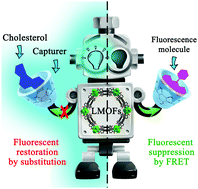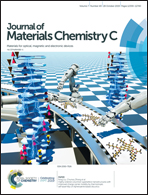Substitution-type luminescent MOF sensor with built-in capturer for selective cholesterol detection in blood serum†
Abstract
The development of an effective strategy for the accurate detection of cholesterol in human serum is of great significance. Herein, a novel luminescent metal–organic framework (LMOF) probe was successfully constructed for the specific detection of cholesterol in blood. Owing to the large size of the mesopores in NU-1000, carboxymethyl β-cyclodextrin (β-CMCD) was grafted onto the LMOF with a high density and designed as an energy-transfer bridge and an inclusion site for cholesterol recognition. Upon adding a blood sample into the sensing system, the free cholesterol inside the serum competes with Rh6G to form a more stable inclusion complex with β-CMCD, and induces the fluorescence restoration of the ligand in LMOF proportionally, which was quenched in advance by Rh6G due to the fluorescent resonance energy transfer (FRET) effect. The specificity of the employed sensing probe for cholesterol recognition was scarcely affected by other possibly coexisting interfering substances. Furthermore, the LOD value was determined to be as low as 0.4 μM, which is far lower than the normal cholesterol level in human serum. This indicates the practical application of the current developed LMOF sensor for the accurate and rapid detection of cholesterol in disease diagnosis.



 Please wait while we load your content...
Please wait while we load your content...